Organization Schema Markup: Step-by-Step Guide for Companies

Originally Published on SEMrush December 11, 2020 (Jason Barnard)
If you have read the great introduction on Schema Markup from Luke Harsel, then you know that Schema Structured Markup is vital for any company, but that over 50% of Fortune 500 companies do not yet use it! It’s an important part of technical SEO that is overlooked.
In this article, I will take you through the steps and best practices when adding structured Schema.org markup for your company to your website… including which format to use, what information you should provide (and why), how to choose a category, how to push your markup further, how to test your markup … and several little-known tips and tricks that will lift your markup above the competition.
All Companies Should Add Schema.org Organization Markup on Their Websites
It is vital to add schema structured markup to your company “About” or Home page. With this markup, you are confirming to a machine what it has almost certainly correctly understood concerning who you are and what you do. Here is Google’s official stance.
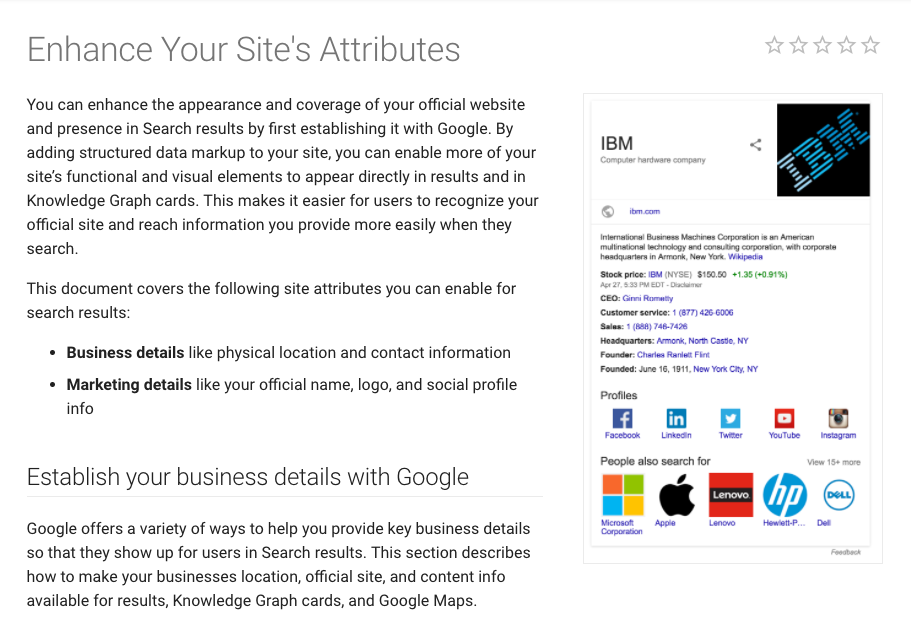
Is organization schema really necessary?
Adding a simple confirmation of who you are may seem marginal. But remember, Google and Microsoft are machines. If there is one thing that machines love it is confirmation of the information in the structured language (their mother-tongue, if you like).
[community-related src=”https://www.semrush.com/blog/what-is-schema-beginner-s-guide-to-structured-data/, https://www.semrush.com/webinars/schema-markup-as-a-tactic-for-aeo/, https://www.semrush.com/blog/learning-technical-seo/”]
Far from being marginal, Schema Structured Markup on your “About” or “Home” page is vital. If you are in any doubt, please re-read Luke’s article (mentioned above).
However, don’t add it to every page! Here’s John Mueller going answering a question about organization schema: https://www.youtube.com/embed/cXbWuQQp81A?start=3094&feature=oembed&enablejsapi=1&origin=https%3A%2F%2Fwww.semrush.com
In search engine’s structured language they want you to:
- Confirm your name, your address, your social media accounts, your official website
- Identify what image, logo, description you want them to show when they mention you (and more often than not, they will use what you provide).
- Provide proof of who you are, and create credibility through third-party confirmation in the “sameAs” field (Crunchbase, Wikipedia, etc.).
There is no reason not to help them, especially as they specifically ask you to!
What format should I use?
Use JSON-LD for organization schema rather than embedding the markup into your HTML. It is much easier to maintain. Plus Google recommends it!
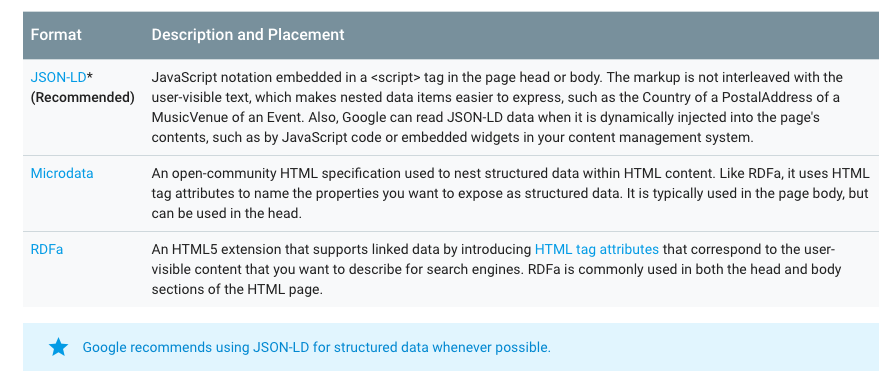 Google’s recommendation is JSON-LD
Google’s recommendation is JSON-LD
You can place the JSON-LD markup anywhere in the page. Most websites put it in the <head> section. This is a logical place to put it, but if your CMS isn’t able to do that, you can put the markup in the body of the content or the footer…or even in an external file.
Interestingly, Google (and Microsoft) can also read your markup if it is in an external file that loads after the page has loaded. For very large sites and for sites that make extensive use of Schema markup, this is a solution that can potentially make managing the structured data much easier.
Here’s the Nitty-Gritty: The Markup for a Company
To start with, a simple example for a Corporation:
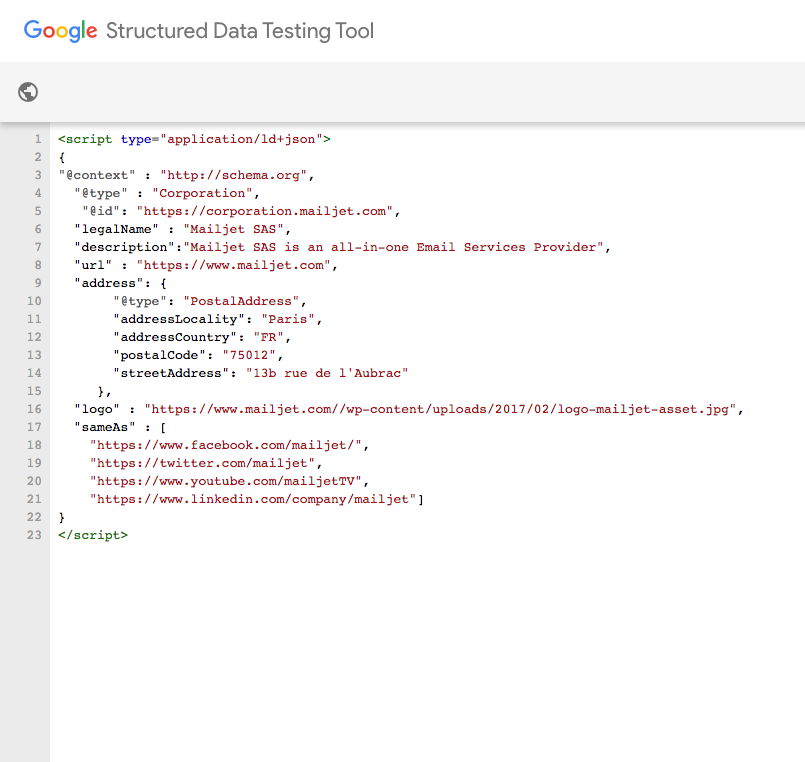 The JSON-LD code.
The JSON-LD code.
Here we state(and this is the very least you should include):
- The type of company
- The company name
- Official website
- Address
- The official logo
- The preferred description
- The social accounts
- The unique identifying URL
Are there other values for : “@type”: “Corporation”?
Yes. Quite a few. The most general is “Organization”. Many companies use this value, for example, Mailjet has used “Corporation”. Here are the top-level options to choose from:
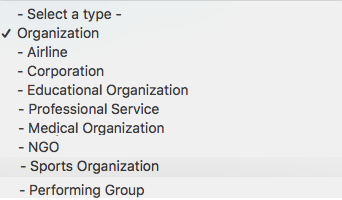
You should choose the most specific value possible. Companies should use Corporation and not the more general Organization. Most Local Businesses will find a category that suits them. Ideally, you should choose the same category you have in Google My Business. However, as My Business and Schema.org do not use the same categorization, that is not always possible. Choose the closest match. There are well over 100, so you can get pretty close. Here are a few examples:
 LocalBusiness Schema Categories Examples
LocalBusiness Schema Categories Examples
If you do not find the right category for your business, you can actually create it. Just find the Wikipedia page that represents your business category, add that to this URL http://www.productontology.org/doc/ and add an “additonalType” to your markup.
For example, if I run a beer shop, and I want to be really specific, LiquorStore isn’t QUITE right. I would get the page for Beer Shop on Wikipedia (https://en.wikipedia.org/wiki/Beer_shop), take the part after /wiki/ to do this.
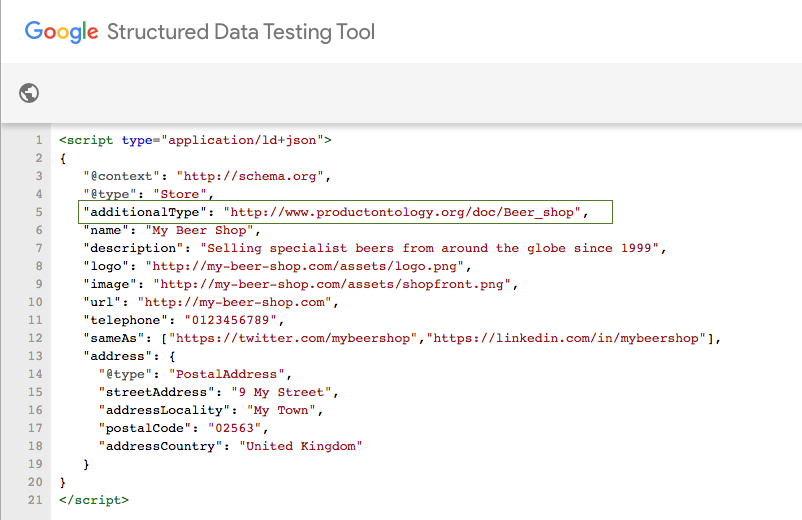
What is this : “@id”: “https://corporation.mailjet.com”?
This is the unique URL that identifies the company, and it is up to you to choose what that URL will be. It can be a URL that returns a page, a URL that returns detailed information in various formats, or (as in this case) a URL that returns nothing. The aim here is to have a unique identifier for the entity.
Once you have provided this, it becomes the explicit, unambiguous reference for your company. Forever (so choose carefully!).
You may be tempted to use your homepage as a unique identifier for your company. However, the homepage (http://www.example.com/) typically “stands for” three things:
- The home page
- The whole website
- The organization
Some people use imaginary (or real) anchors:
- The home page: http://www.example.com/
- The whole website: http://www.example.com/#site
- The organization: http://www.example.com/#organization
I recommend using a unique subdomain of the company domain (remember they do not need to exist or give access to a page to be valid as a unique identifier).
How This System Will Scale
Dedicated subdomains, and URI for each entity – product / person / company / place / office with Schema-compatible anchors for “explaining” the details is the only system that will work over time.
A unique, never-changing subdomain with hashtags / anchors:
- Allows you to have the truly never changing id (which is what these machines are looking for)
- Allows you to keep UE and machine understanding apart (anyone who has tried pleasing both users and machines at the same time knows this can get complicated)
- Allows you to add anchors for detail without worrying about effects on UE navigation
- Most importantly – allows you to add data to the URL. The subdomain (URL) CAN return data in Schema format – including product details and very IMPORTANTLY the current active URL for the UE. Meaning that machines would always come to this URL to find current (reliable) information about any given entity. Using this system, you can inform / educate the machines without impacting UE. As long as you always refer explicitly to the URL intended for users that provides the same information, and that the information on both is coherent, the machines will thank you.
Extending Organization Schema Markup for a Company
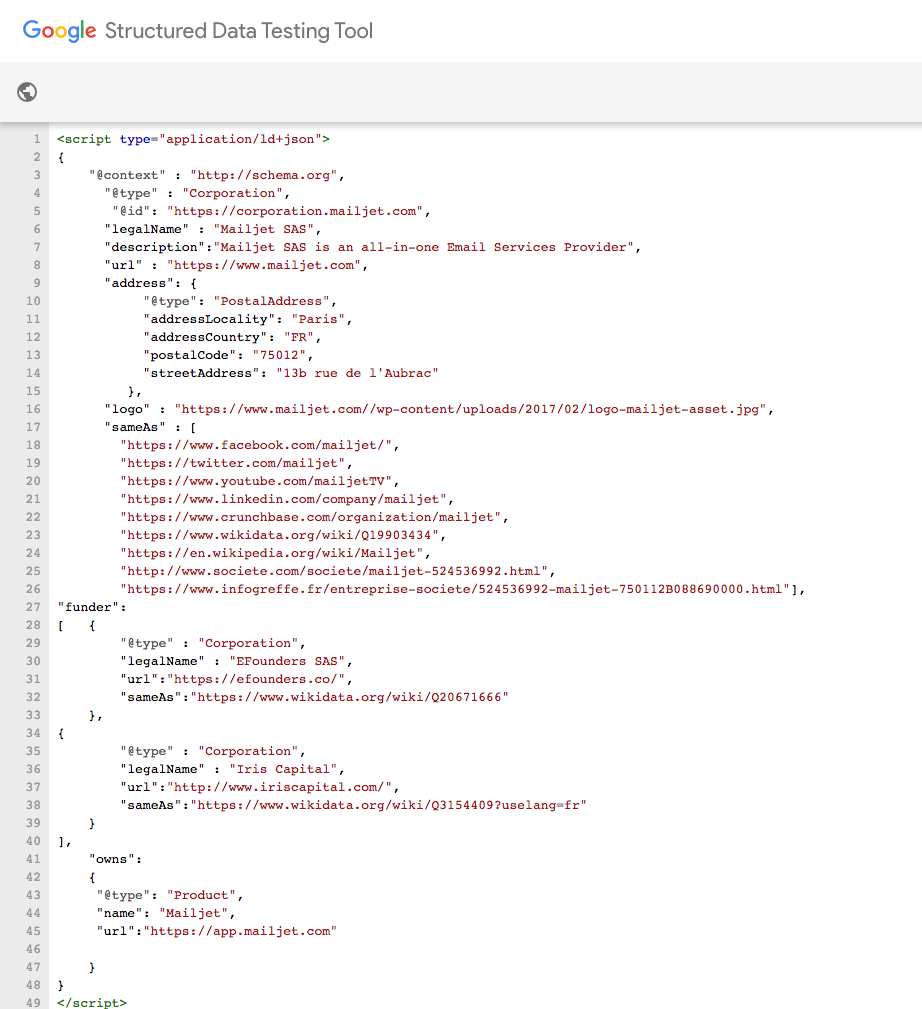
Here we have added:
- Several reliable references to the company,
- Some investors
- The product the company offers (an emailing platform)
Here is what Google “sees”. It is very, very clear.
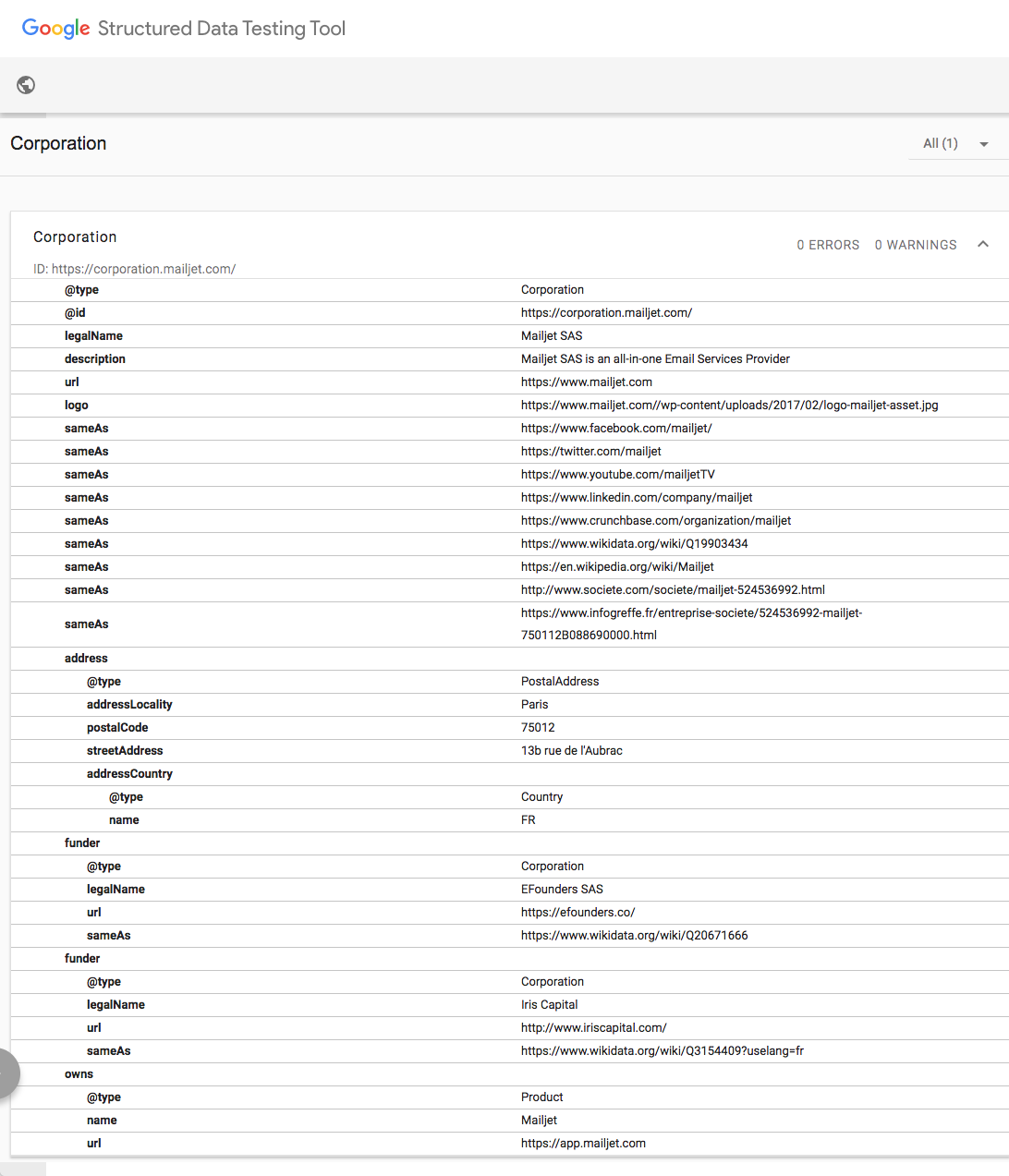
Taking It Even Further
We could also have added information such as the founders, the management team, sub-organizations, area served, client rating, etc. The list is pretty extensive.
The more ACCURATE and pertinent information you can provide, the better.
Here is the list of possibilities on Schema.org/Corporation.
Local Businesses can add opening hours, geo-coordinates, prices, telephone, fax…
Here is the list of possibilities on Schema.org/LocalBusiness.
Which element of the markup is the most important?
“sameAs”- this property is the key.
These links provide 1) third party confirmation 2) credibility 3) context 4) additional information
Typical examples of great sameAs links:
- Wikipedia
- Wikidata
- Crunchbase
- Official company listing (for example Companieshouse.gov.uk)
- Business organizations of which the company is a member
- Your company profile pages on review sites
Useful Tools for Corporation Schema
Corporation Schema markup creation and validation are not that hard as you could think. Moreover, there are two incredible tools that will ease these processes for you.
Creating the Markup Easily
Here is a great tool from Kalicube®.pro that automatically generates structured markup need is JSON-LD format. One of the few tools out there that allows multiple sameAs links.
Create Schema Structured Markup for your company.
Checking Your Markup is Error-Free
ALWAYS double-check your structured markup once implemented on your site. Here is a super-cool tool that does that for you.
Structured Markup for Your Company Makes Sense From Every Perspective
Far from being marginal, Schema Structured Markup on your website is vital. Start today.



